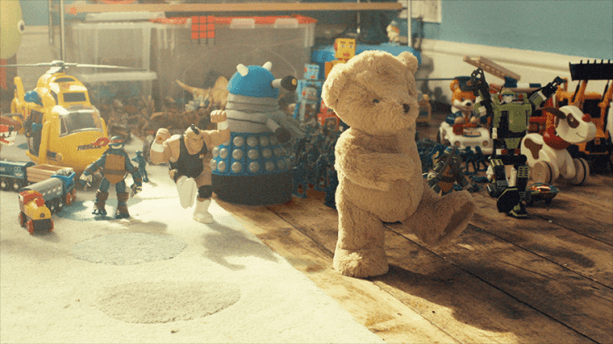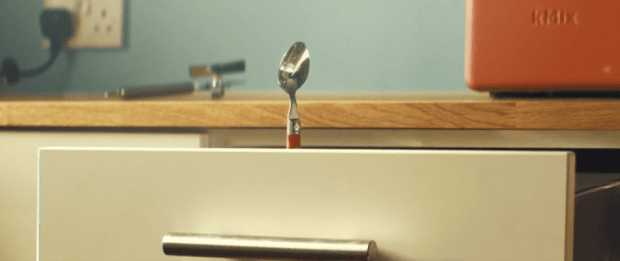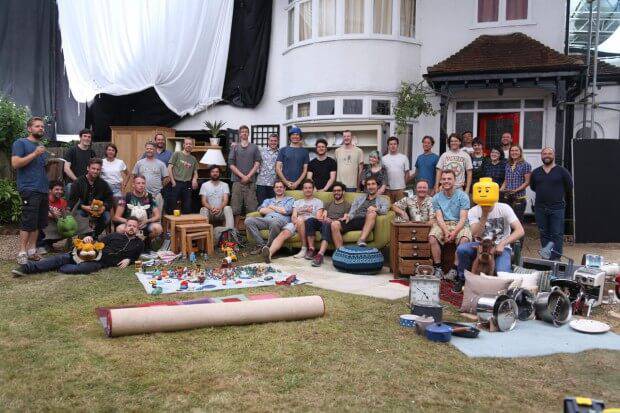Animator Mark Waring on the John Lewis “What Matters Most” Campaign
Earlier this month, John Lewis released the new stop-motion advert for their £5million household insurance campaign. The shoot – which involved well over 100 individual moving objects – was animated in a suburban house with live action actors and a mammoth crew. Created in only three weeks, the 1:30min sequence demonstrates sheer ingenuity with everything from books to beds being animated frame by frame on location.
Skwigly had the pleasure of interviewing the project’s Animation Supervisor Mark Waring, who has worked on some of the biggest stop-motion productions of recent years, such as Frankenweenie, Corpse Bride and Fantastic Mr Fox as well as commercial work for CMON cars. We took the opportunity to discuss the what matters most campaign and just what it takes to create a large scale production to a short-term deadline.
Can you give us some insight into the amount of planning that had to go into such a massively ambitious, large-scale production?
A lot of the planning processes stemmed from director Dougal Wilson’s storyboard, we were basically just finding ways to create his vision. We had a couple of months of pre-production, but this time was used differently for each department. For example, the art department had to source and gather a huge range of household items before passing them to the rigging department who could then prep the props for shooting. Only then could the animation team get their hands on these items to start rehearsing. Finding the location and the logistics involved in planning such a shoot proved time-consuming, as all shooting was to be completed on location rather than in a studio environment.
The scheduling of this was a key part and there were many recces to the chosen location by the key members of the crew to decide how the shoot would, or could, be achieved. From an animation standpoint, there were two weeks of animation testing before the shoot. This was needed to find out how some of the key objects would move before actually getting to the location. During this time there was a conscious process of trying to create character in certain items and to give everything a unique way of moving. By working with the rigging department we had to find out how to animate things as diverse as achieving hundreds of scampering books, how to support baths running down stairs as well as creating an army of walking bunny rabbits, wardrobes, pots, pans and grandfather clocks!
What complications did you encounter during production?
I think the most complicated part was the challenge of shooting it all on location. We had to work in and around a real house and all of the space limitations that that entails. We had at least three animation units shooting at any one time, so if someone was shooting in the hall, someone was next door shooting in the lounge while another unit was working in the bedroom. Juggling the crew, camera equipment, motion control, lighting, and keeping everything moving through a three week shoot was always going to be complicated, but with time well spent in pre-production planning and scheduling, amazingly we managed to keep it all together.
It must have been difficult keeping track of the hundreds of moving elements, what systems did you have in place to keep everything in order?
When animating we are aided with a system called Dragonframe. This is software that records what you are shooting frame by frame so you can review your animation as you progress through the shot. This system also helps to programme lighting set ups and also runs motion control, so it has obviously become a very popular tool for all departments of a stop frame unit.
The concept behind the film is “if it matters to you, it matters to us” – how did the story develop during production?
The story was worked out at the storyboard stage by Dougal, but there was room for development as the pre production testing stage progressed as certain objects took on characters and little mini scenarios developed. There was logic as to why and where things happened, and all of this had to be pre-planned. The ad develops and expands as you watch, so the relationships between the items gets more and more complex as we had to work out the logistics of where everything would end up. Within this structure there was room for a few little added fun bits, like the girl with the bunny rabbit and with the teddies if you look carefully!
What was your favourite scene or moment in the advert?
I think my favourite scene is when all the items pour out of the house and all over the lawn. It was such a huge shot to shoot and involved so many people that I imagine it probably won’t be attempted by anyone anytime soon. On a smaller scale I also like the spoons popping out of the drawer, like a bunch of metal meerkats!
How did your role break down during the film making process?
I was the Animation Supervisor on the commercial. This involved initially helping put together the animation crew and working with the 1st AD to create an initial schedule based on how long I thought the animation shoot would take. It then developed into working with the other heads of the departments into the logistics of how the animation could be achieved to bring Dougal’s vision to life. This included supervising the testing process and then ultimately animating on the shoot itself.
What has the initial response been to the advert?
The response seems to be incredibly positive. I have had many people messaging saying that they have just seen the ad and sending congratulations on such an epic job.
Would you like the opportunity to work on something like this again?
Of course! It was incredibly hard job, both mentally and physically, but the rewards are well worth the pain! The crew were amazing and it would be a huge pleasure to work with them again.
How does working on an advert like this compare to your work on feature films like Fantastic Mr Fox or Frankenweenie?
They are completely different disciplines. The time frames of the shoots are so different – a year and a half compared to three weeks – that you have to view it as if the films are like running a marathon and the commercials a sprint. However both styles of work have to have the same focus and attention to detail that makes stop frame so unique. The joy of working around so many skilled people is the same for both types of work, and of course it all comes together when the projects are completed and you get to view the results. That’s what makes it all so exciting!
You can catch the advert on television now. John Lewis has also started a Vine competition where you can create your 6 second mini movie using Vine. Animate what matters most to you, post it to Twitter using #whatmattersmost and you could be in with the chance of winning £1000 in John Lewis vouchers or one of three Canon 700D cameras. Not too shabby – might give it a go myself….




